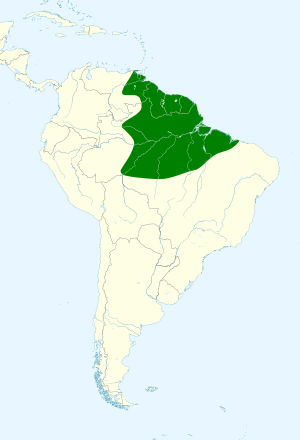Golden-winged parakeet
| Golden-winged parakeet | |
|---|---|

| |
| at Cristalino Lodge, Southern Amazon, Brazil | |
| Scientific classification | |
| Kingdom: | Animalia |
| Phylum: | Chordata |
| Class: | Aves |
| Order: | Psittaciformes |
| Family: | Psittacidae |
| Genus: | Brotogeris |
| Species: | B. chrysoptera
|
| Binomial name | |
| Brotogeris chrysoptera (Linnaeus, 1766)
| |

| |
| Synonyms | |
|
Psittacus chrysopterus Linnaeus, 1766 | |
The golden-winged parakeet (Brotogeris chrysoptera) is a species of bird in the family Psittacidae, the true parrots.
Taxonomy
The golden-winged parakeet was formally described in 1766 by the Swedish naturalist Carl Linnaeus in the twelfth edition of his Systema Naturae. He placed it with all the other parrots in the genus Psittacus and coined the binomial name Psittacus chrysoptetus.[2] Linnaeus based his description on the "golden-winged parakeet" that had been described and illustrated in 1760 by the English naturalist George Edwards in the second volume of his Gleanings of Natural History.[3] Edwards was uncertain about the origin of his specimen. Linnaeus specified the type location as "India". It was redesignated as "Guiana" in 1912.[4][5] The golden-winged parakeet is now one of eight species placed in the genus Brotogeris that was introduced in 1925 by Irish zoologist Nicholas Aylward Vigors.[6][7] The genus name is from the Ancient Greek brotogērus meaning "with human voice". The specific epithet chrysoptera is from the Ancient Greek khrusopteros meaning "golden-winged" (from khrusos "gold" and pteron "wing").[8]
Five subspecies are recognised:[7]
- B. c. chrysoptera (Linnaeus, 1766) – northeast Venezuela through the Guianas and north-central Brazil
- B. c. tenuifrons Friedmann, 1945 – Rio Negro (northwest Brazil)
- B. c. solimoensis Gyldenstolpe, 1941 – Codajás and Manaus regions (north Brazil)
- B. c. tuipara (Gmelin, JF, 1788) – central Brazil
- B. c. chrysosema Sclater, PL, 1864 – west Brazil
Distribution and habitat
It is found in Brazil, French Guiana, Guyana, Suriname, (the Guianas), and Venezuela in the eastern Amazon Basin and the lower Orinoco River region of eastern Venezuela. Its natural habitats are subtropical or tropical moist lowland forests and heavily degraded former forest.
The golden-winged parakeet can be found mostly in the eastern Amazon Basin, and upstream on the Amazon River to eastern Amazonas state Brazil; to the southwest, 1700 km upstream on the Madeira River to the border of Bolivia.
In the northeast Basin, the range is contiguous into the Guianas, the Guiana Shield and westward into eastern Venezuela. In Roraima state Brazil bordering eastern Venezuela, all but the northwest is in the range; the range continues south to the Amazon River down Roraima's Branco River, and then continues west upriver on the Rio Negro as the furthest west range extension.
For the southeast quadrant of the Amazon Basin, only the lower half of the tributary rivers are in the bird's range, in Amazonas, Pará, and Maranhão states. Very northern Tocantins state is included at the Araguaia-Tocantins River confluence. Amapá state in the northeast bordering French Guiana is the last Brazilian state with the parakeet's range; it is also on Marajó Island, Ilha de Marajo. The two other rivers in the center of the south range are the north flowing Tapajós and Xingu River systems.
The golden-winged parakeet is also found in northeastern Venezuela in the downstream regions surrounding the Orinoco River; the contiguous range continues eastward into Guyuna and the Guiana Shield highlands and southeastwards into Roraima.
References
- ^ BirdLife International (2016). "Brotogeris chrysoptera". IUCN Red List of Threatened Species. 2016: e.T22685986A93095301. doi:10.2305/IUCN.UK.2016-3.RLTS.T22685986A93095301.en. Retrieved 12 November 2021.
- ^ Linnaeus, Carl (1766). Systema naturae : per regna tria natura, secundum classes, ordines, genera, species, cum characteribus, differentiis, synonymis, locis (in Latin). Vol. 1, Part 1 (12th ed.). Holmiae (Stockholm): Laurentii Salvii. p. 149.
- ^ Edwards, George (1760). Gleanings of Natural History, Exhibiting Figures of Quadrupeds, Birds, Insects, Plants &c. Vol. 2. London: Printed for the author. p. 177, Plate 293, fig. 2.
- ^ Brabourne, W.; Chubb, C. (1912). The Birds of South America. London: R.H. Porter. p. 88.
- ^ Peters, James Lee, ed. (1937). Check-List of Birds of the World. Vol. 3. Cambridge, Massachusetts: Harvard University Press. p. 207.
- ^ Vigors, Nicholas Aylward (1825). "On the arrangement of the genera of birds". Zoological Journal. 2: 391-405 [400].
- ^ a b Gill, Frank; Donsker, David; Rasmussen, Pamela, eds. (January 2022). "Parrots, cockatoos". IOC World Bird List Version 12.1. International Ornithologists' Union. Retrieved 22 March 2022.
- ^ Jobling, James A. (2010). The Helm Dictionary of Scientific Bird Names. London: Christopher Helm. pp. 78, 105. ISBN 978-1-4081-2501-4.
External links
- World Parrot Trust Parrot Encyclopedia - Species Profiles
- Stamps (for Suriname) with RangeMap
- Golden-winged parakeet photo gallery VIREO
- Photo-High Res; Article www1.nhl.nl—"Suriname Birds"Error: "Q371405" is not a valid Wikidata entity ID.
- CS1: long volume value
- CS1 Latin-language sources (la)
- Articles with short description
- Short description with empty Wikidata description
- IUCN Red List least concern species
- Articles with 'species' microformats
- Taxonbars desynced from Wikidata
- Taxonbar pages requiring a Wikidata item
- Taxonbars with invalid from parameters
- Taxonbars without secondary Wikidata taxon IDs
- Brotogeris
- Birds of the Guianas
- Birds of the Amazon Basin
- Birds of Brazil
- Birds described in 1766
- Taxa named by Carl Linnaeus
- Taxonomy articles created by Polbot
